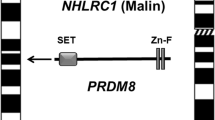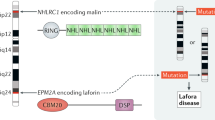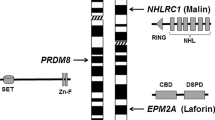Abstract
Lafora progressive myoclonus epilepsy is an autosomal recessive, fatal, generalized polyglucosan storage disorder that occurs in childhood or adolescence with stimulus sensitive epilepsy (resting and action myoclonias, grand mal, and absence), dementia, ataxia and rapid neurologic deterioration. Mutations in EPM2A/laforin cause 58% of cases and mutations in EPM2B/malin cause 35% of cases. Accumulating evidence points to Lafora disease as primarily a disorder of cell death with impaired clearance of misfolded proteins, as shown by ubiquitin-positive aggresomes in HeLa cells transfected with mutated laforin, ubiquitin-positive polyglucosan inclusion bodies, and malin/E3 ubiquitin ligase polyubiquitination of laforin. How polyglucosan inclusion bodies accumulate is still a mystery. Polyglucosan accumulates hypothetically because of an overactive polyglucosan biosynthetic pathway or a breakdown in polyglucosan degradation. Five separate laboratories are looking for the biochemical pathways that connect laforin and malin to polyglucosan synthesis or degradation. A curative therapy for human Lafora disease with laforin replacement therapy using neutral pegylated immunoliposomes is being investigated.
Similar content being viewed by others
References and Recommended Reading
Minassian BA, Lee JR, Herbrick JA, et al.: Mutations in a gene encoding a novel protein tyrosine phosphatase cause progressive myoclonus epilepsy. Nat Genet 1998, 20:171–174.
Ganesh S, Agarwala KL, Ueda K, et al.: Laforin, defective in progressive myoclonus epilepsy of Lafora type, is a dual specificity phosphatase associated with polyribosomes Hum Mol Genet 2000, 9:2251–2261.
Chan EM, Young EJ, Ianzano L, et al.: Mutations in NHLRC1 cause progressive myoclonus epilepsy. Nat Genet 2005, 35:125–127.
Chan EM, Omer S, Ahmed LR, et al.: Progressive myoclonus epilepsy with polyglucosans (Lafora disease): evidence for a third locus. Neurology 2004, 63:565–567.
Lafora GR, Glueck B: Contribution to the histopathology and pathogenesis of myoclonic epilepsy. Bull Gov Hosp Insane 1911, 3:96–111.
Lafora GR: The presence of amyloid bodies in the protoplasm of the ganglion cells; a contribution to the study of the amyloid substance in the nervous system. Bull Gov Hosp Insane 1911, 3:83–92.
Schwarz G, Yanoff M: Lafora’s disease. Distinct clinicopathologic form of Unverricht’s syndrome. Arch Neurol 1965, 12:172–188.
Schwarz GA, Yanoff M: Lafora bodies, corpora amilacea, and Lewy bodies: a morphological and histochemical study. Arch Neurobiol (Madrid) 1965, 28:800–818.
Acharya JN, Satischandra P, Asha T, Shankar SK: Lafora’s disease in south India: a clinical, electrophysiologic, and pathologic study. Epilepsia 1993, 34:476–487.
Sakai M, Austin J, Witmer F, et al.: Studies in myoclonus epilepsy (Lafora Body Form) II. Polyglucosans in systemic deposits of myoclonus epilepsy and in corpora amylacea. Neurology 1970, 20:160–176.
Raben N, Danon M, Lu N, et al.: Surprises of genetic engineering: a possible model of polyglucosan body disease. Neurology 2001, 56:1739–1745.
Ziemssen F, Sindern E, Schröder JM, et al.: Novel missense mutations in the glycogen-branching enzyme gene in adult polyglucosan body disease. Ann Neurol 2000, 47:536–540.
Serratosa JM, Delgado-Escueta AV, Posada I, et al.: The gene for progressive myoclonus epilepsy of the Lafora type maps to chromosome 6q. Hum Mol Gen 1995, 4:1657–1663.
Sainz J, Minassian BA, Serratosa JM, et al.: Lafora progressive myoclonus epilepsy: narrowing the chromosome 6q24 locus by recombinations and homozygosities. Am J Hum Genet 1997, 61:1205–1209.
Ganesh S, Delgado-Escueta AV, Sakamoto T, et al.: Targeted disruption of the Epm2a gene causes formation of Lafora inclusion bodies, neurodegeneration, ataxia, myoclonus epilepsy and impaired behavioral response in mice. Hum Mol Genet 2002, 12:1–12.
Chan EM, Ackerley CA, Lohi H, et al.: Laforin preferentially binds the neurotoxic starch-like polyglucosans, which form in its absence in progressive myoclonus epilepsy. Hum Mol Genet 2004, 13:1117–1129.
Ganesh S, Delgado-Escueta AV, Suzuki T, et al.: Genotype-phenotype correlations for EPM2A mutations in Lafora’s progressive myoclonus epilepsy: exon 1 mutations associate with an early-onset cognitive deficit subphenotype. Hum Mol Genet 2002, 11:1263–1271.
Ganesh S, Tsurutani N, Suzuki T, et al.: The carbohydratebinding domain of Lafora disease protein targets Lafora polyglucosan bodies. Biochem Biophys Res Comm 2004, 313:1101–1109.
Fernandez-Sanchez ME, Criado-García O, Heath KE, et al.: Laforin, the dual-phosphatase responsible for Lafora disease, interacts with R5 (PTG), a regulatory subunit of protein phosphatase-1 that enhances glycogen accumulation. Hum Mol Genet 2003, 12:3161–3171.
Wang W, Roach PJ: Glycogen and related polysaccharides inhibit the laforin dual-specificity protein phosphatase. Biochem Biophys Res Commun 2004, 325:726–730.
Wang J, Stuckey JA, Wishart MJ, Dixon JE: A unique carbohydrate binding domain targets the Lafora disease phosphatase to glycogen. J Biol Chem 2002, 277:2377–2380.
Ganesh S, Tsurutani T, Suzuki T, et al.: The Lafora disease gene product laforin interacts with HIRIP5, a phylogenetically conserved protein containing a NifU-like domain. Hum Mol Gen 2003, 12:2359–2368.
Ianzano L, Zhao XC, Minassian BA, Scherer SW: Identification of a novel protein interacting with laforin, the EPM2a progressive myoclonus epilepsy gene product. Genomics 2003, 81:579–587.
Doherty MJ, Young PR, Cohen PT: Amino acid sequence of a novel protein phosphatase 1 binding protein (R5) which is related to the liver-and muscle-specific glycogen binding subunits of protein phosphatase 1. FEBS Lett 1996, 399:339–343.
Singh S, Sethi I, Francheschetti S, et al.: Novel NHLRC1 mutations and genotype-phenotype correlations in patients with Lafora’s progressive myoclonus epilepsy. Am J Med Genet 2007, In press.
Gomez-Abad C, Gomez-Garre P, Gutierrez-Delicado E, et al.: Lafora disease due to EPM2B mutations: a clinical and genetic study. Neurology 2005, 64:982–986.
Gentry MS, Worby CA, Dixon JE: Insights into Lafora disease: malin is an E3 ubiquitin ligase that ubiquitinates and promotes the degradation of laforin. Proc Natl Acad Sci U S A 2005, 102:8501–8506.
Machado-Salas J, Bai D, Avila MR, et al.: Lafora disease: a disorder of protein degradation and clearance? Paper presented at the American Academy of Neurology. San Francisco, CA; April, 2004.
Machado-Salas J, Avila MR, Yamakawa K, et al.: Cell death in transgenic mice model of Lafora disease. Paper presented at the American Neurological Association Annual Meeting. San Francisco, CA; October, 2003.
Lohi H, Ianzano L, Zhao XC, et al.: Novel glycogen synthase kinase 3 and ubiquitination pathways in progressive myoclonus epilepsy. Hum Mol Genet 2005, 14:2727–2736.
Minassian BA: Lafora’s disease: towards a clinical, pathologic and molecular synthesis. Pediatr Neurrol 2001, 25:21–29.
Niityla T, Comparot-Moss S, Lue WL, et al.: Similar protein phosphatases control starch metabolism in plants and glycogen metabolism in mammals. J Biol Chem 2006, 281:11815–11818.
Delgado-Escueta AV, Ganesh S, Yamakawa K: Advances in the genetics of progressive myoclonus epilepsy. Am J Med Genet 2001, 106:129–138.
Raben N, Nagaraju K, Lee E, Plotz P: Increased glycogen load accelerates the course of the disease in the acid alphaglucosidase knockout mice. Am J Hum Genet 1999, 65:486.
Kyllerman M, Ben-Menachem E: Zonizamide for progressive myoclonus epilepsy: long term observations in seven patients. Epilepsy Res 1998, 29:109–114.
Chan EM, Andrade DM, Franceschetti S, et al.: Progressive myoclonus epilepsy: EPM1, EPM2A, EPM2B in myoclonic epilepsies. Adv Neurol 2005, 95:47–58.
Shi N, Pardridge WM: Noninvasive gene targeting to the brain. Proc Natl Acad Sci U S A 2000, 97:7567–7572.
Author information
Authors and Affiliations
Corresponding author
Rights and permissions
About this article
Cite this article
Delgado-Escueta, A.V. Advances in Lafora progressive myoclonus epilepsy. Curr Neurol Neurosci Rep 7, 428–433 (2007). https://doi.org/10.1007/s11910-007-0066-7
Published:
Issue Date:
DOI: https://doi.org/10.1007/s11910-007-0066-7




